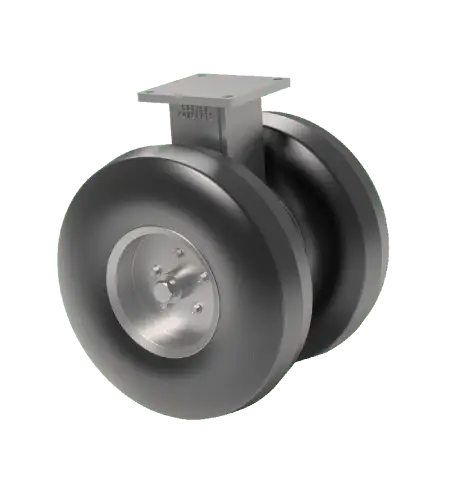

Pneumatic wheels are used in many different industrial applications for a variety of reasons. Like most caster types, these do have their benefits and downfalls. Here, you will learn more about these wheels, the applications in which they are used, and more so you can make a better decision about your own needs.
Pneumatic wheels are designed to mimic car tires. Essentially, they are rubber wheels fitted around a metal hub, and while many are filled with air, some may also be filled with soft foam. They come in a variety of different sizes and styles, and they are available for anything from light-duty to heavy-duty applications. Not every application can benefit from pneumatic wheels, but others may discover they are the best options for their needs.
The number one reason why people choose pneumatic wheels when it comes to their industrial applications is for their shock absorbency. These wheels can absorb shock better than most other materials, which makes them ideal for transporting loads over uneven surfaces, in areas where debris may be present, or even for moving fragile loads that may shift or break if a “bump” occurs. They are perfect for use both on and off pavement, making them incredibly popular for outdoors applications. They are naturally quieter than many other types of wheels, and this can provide better working conditions when they are used indoors.
The benefits of pneumatic wheels are evident, but there are some downfalls to consider, as well. Because the wheels are softer, they require more initial force to start moving. The wheels are more difficult to swivel, as well. Monitoring air pressure is vital because a flat pneumatic wheel makes it impossible to move a load from one location to another. Sometimes, people choose to fill the wheels with a soft polyurethane foam, and while this does help to prevent flats, it also sacrifices some of the “sponginess” of the wheel and makes it less shock absorbent.
If you regularly move heavy loads outdoors, pneumatic wheels may be the best option for you. They do take a bit more force to start and turn, but once moving, they handle bumps in the road, rocks, and other pieces of debris wonderfully – all without jarring the load around and potentially causing damage. Pneumatic wheels are also fantastic for applications like gurneys, hospital beds or motorized chairs because they absorb shock and keep the patient or user far more comfortable, especially when these are rolled outside over pavement, grass, and other types of terrain.
Pneumatic wheels are some of the best shock absorbers out there, so if you’re moving fragile loads across rough terrain, it’s always worth looking into. However, they are not the best choice for every situation, so it’s always a good idea to consult with experts to determine the best features for your needs. Dozens of caster and wheel combinations exist, so there is something out there that suits every single application.